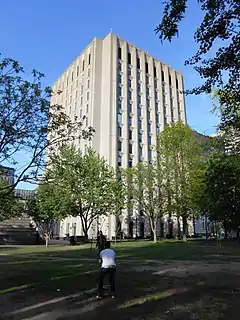Burnside Hall
Burnside Hall (French: Pavillon Burnside) is a McGill University building located at 805 Sherbrooke Street West, on the university's downtown campus in Montreal, Quebec. It is named after Burnside Place, the Montreal estate of James McGill, the university's founder.[1] Built in 1970 by Marshall, Merrett, and Associates to accommodate the Faculty of Science, the thirteen-storey building is constructed in Brutalist style and stands just northeast of the Roddick Gates, in the centre of McGill's campus.[2]
| Burnside Hall | |
|---|---|
 View from centre of Lower Field (2013) | |

| |
| General information | |
| Architectural style | Brutalism |
| Address | 805 Sherbrooke Street West, Montreal, Quebec, Canada |
| Coordinates | 45.5048°N 73.5749°W |
| Completed | 1970 |
| Affiliation | McGill University |
| Height | 48.75 m (159.9 ft) |
| Technical details | |
| Material | Concrete |
| Floor count | 14 |
| Design and construction | |
| Architecture firm | Marshall, Merrett, and Associates |
The building currently houses the Departments of Atmospheric & Oceanic Sciences, Geography, Mathematics and Statistics, the Network and Communications Services (NCS), the Walter Hitschfeld Geographic Information Centre (GIC) and the Edward Rosenthall Mathematics & Statistics Libraries at the university.[2]
Layout
Burnside is located south of the Macdonald-Stewart Library (formerly the Macdonald Physics Building), southeast of the Pulp and Paper Research Institute and northeast of the Otto Maass Chemistry Building. Burnside connects to these buildings through an underground tunnel system, and can also be accessed from the outside directly from McGill's Lower Field through the building's main entrance.

The basement contains the largest classrooms, under the building's concrete terrace.[2] The basement also provides a study space open to students 24/7.[3] and is one of the most popular locations on campus for tutorials, group study, lunch. It contains a café, computer labs, tables and sofas.[4] The first floor is used as a lobby and the second floor belongs to the Computing Centre, which contains a wide variety of computing and graphic laboratories and facilities.[3] The Department of Atmospheric & Oceanic Sciences is located on three floors of Burnside Hall, while the Department of Geography, the Department of Mathematics and Statistics, the Network and Communications Services (NCS), the Walter Hitschfeld Geographic Information Centre (GIC) and the Edward Rosenthall Mathematics & Statistics Libraries are located elsewhere within the building.
The roof contains meteorological equipment belonging to the Department of Atmospheric & Oceanic Sciences for the study of wind, clouds and precipitation in the city.[5] This equipment includes a radar wind profiler and a laser ceilometer.[3]
Design
Burnside Hall was completed in 1970 in Brutalist style[6] by the architecture firm Marshall, Merrett and Associates. The building contains no ornament on its facade, which comprises a repetitive pattern of precast concrete slabs with fixed, glazed windows throughout. Its concrete shell was intended to blend well with the colour and texture of other buildings on campus, namely the Leacock Building and McLennan Library.[2] The building was designed in a way that it could be expanded by an additional five storeys if need be.[2]
See also
- McGill University buildings
- McCall MacBain Arts Building
- Macdonald-Harrington Building
- McGill School of Architecture
References
- Burnside Hall on the McGill Math Department site
- "Burnside Hall". Canadian Architecture Collection. Retrieved 25 March 2020.
- "Burnside Hall". Atmospheric and Oceanic Sciences, McGill University. Retrieved 25 March 2020.
- "Burnside Hall, Brutal Lecture". MyCourses. Retrieved 25 March 2020.
- "Burnside Hall". McGill Virtual Campus Tour. Retrieved 25 March 2020.
- Josefsson, Kira (March 23, 2009). "Rethinking raw concrete". McGill Daily. Retrieved 8 October 2012.
